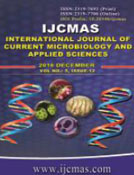


 National Academy of Agricultural Sciences (NAAS)
National Academy of Agricultural Sciences (NAAS)

|
PRINT ISSN : 2319-7692
Online ISSN : 2319-7706 Issues : 12 per year Publisher : Excellent Publishers Email : editorijcmas@gmail.com / submit@ijcmas.com Editor-in-chief: Dr.M.Prakash Index Copernicus ICV 2018: 95.39 NAAS RATING 2020: 5.38 |
To study the distribution, biofilm formation and antifungal susceptibility pattern of Candida species isolated from neonatal candidemia patients. Candida infections are a serious problem in neonatal intensive care units leads to increasing morbidity and mortality. A prospective observational study was conducted from September 2014 to June 2016. A total of 313 blood samples received in Microbiology department from NICU patients with suspected Candida infection were collected. Samples were processed by Gram staining, KOH mount & culture on SDA and BHI agar. Isolated yeasts were identified and speciated by germ tube test, chlamydospores formation on corn meal agar, color production on CHROM agar, sugar fermentation test and sugar assimilation test. Antifungal susceptibility testing of isolates was performed as per CLSI guidelines. Biofilm production was tested by Tube method and Tissue culture plate method. The data was statistically analysed using the statistical package for Social science (SPSS)/21.0. A total of 60 (19.17%) samples out 313 blood samples were positive for candida infections. Most common fungal isolate was Candida tropicalis (45%) followed by Candida albicans (25%), C. parapsilosis (11.7%), C. glabrata (11.7%) and C. krusei (6.7%.). Maximum resistance was observed to Fluconazole & Ketoconazole. Antifungal resistant was found to be more in biofilm producers. This Study highlights the emergence of Non albicans Candida as major isolates and increasing antifungal resistance.
 |
 |
 |
 |
 |